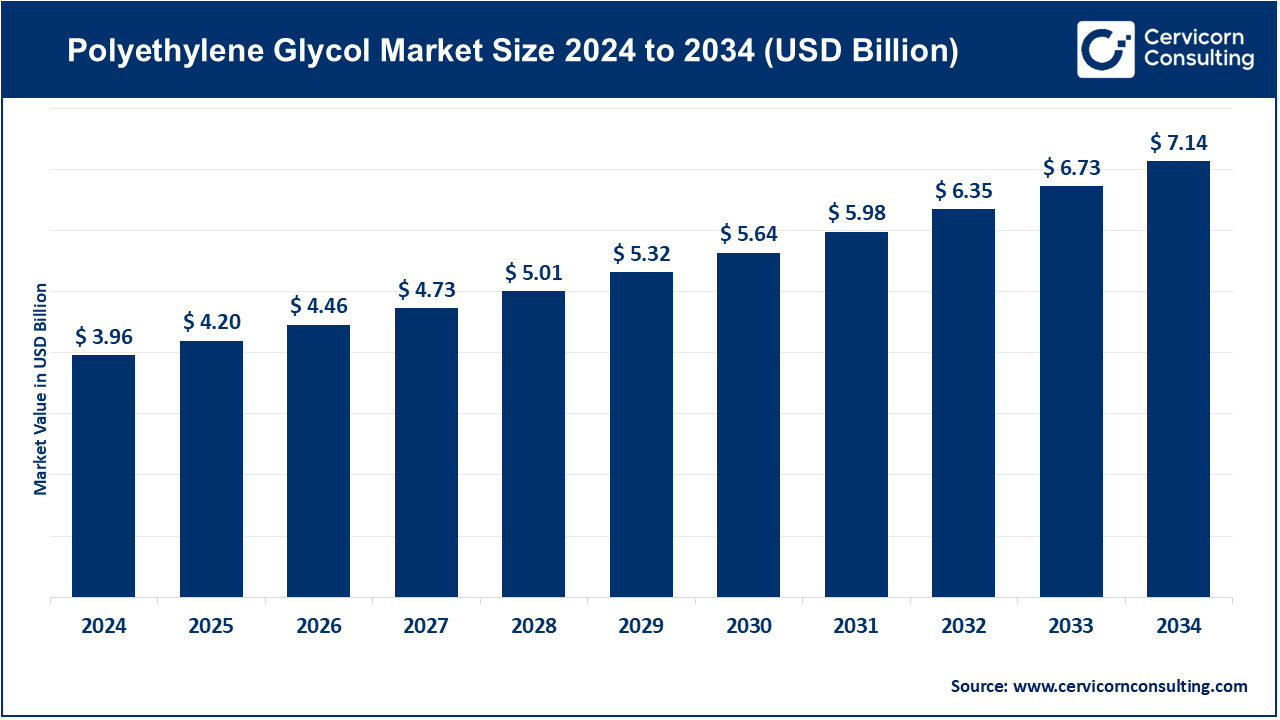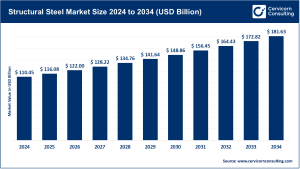Market Overview
The global polyethylene glycol (PEG) market is witnessing robust growth, driven by its extensive use across pharmaceuticals, personal care, cosmetics, industrial processes, paints, and agrochemicals. Recent reports indicate that the market was valued at USD 3.96 billion in 2024 and is anticipated to reach approximately USD 7.14 billion by 2034, reflecting a CAGR of 6.1% between 2025 and 2034.
PEG, a polyether compound produced via ethylene oxide polymerization, is available in multiple molecular weights (e.g., PEG-200, PEG-400, PEG-4000), which enhances its versatility. Its applications range from excipients in drug delivery and PEGylated biologics to humectants in cosmetics and solvents in coatings, positioning PEG at the intersection of commodity and specialty chemicals.
Get a Free Sample: https://www.cervicornconsulting.com/sample/2747
Key Market Trends
Rising Demand for Pharma-Grade PEGs
Pharmaceutical companies are increasingly adopting PEG in drug delivery systems and biologics (PEGylation) to extend drug half-lives. The growth of biologics and biosimilars is driving the demand for high-purity, pharmacopeia-compliant PEG grades, which typically command premium pricing.
Expansion in Personal Care and Cosmetics
PEG is widely employed in skincare, haircare, and oral care products as a humectant, emulsifier, and solubilizer. With global skincare sales projected to exceed USD 200 billion by 2030, demand for PEG in cosmetics is rising, especially in Asia-Pacific and Europe, where premium personal care markets are thriving.
Sustainability and Regulatory Influence
Stringent environmental and safety regulations are shaping PEG production and usage. Manufacturers are increasingly focusing on eco-friendly PEG derivatives and greener ethoxylation processes, in line with global sustainability trends. Compliance with REACH in Europe and FDA guidelines in the U.S. is driving product innovation and strategic supply planning.
Technological Advancements in PEG Derivatives
Innovation in specialty PEG derivatives, such as reactive PEGs, block copolymers, and methylated PEGs, is expanding applications in advanced formulations like controlled-release drug matrices and PEG-based surfactants, enhancing per-unit value.
Regionalization of Supply Chains
Global supply disruptions are prompting regional PEG production hubs, particularly in Asia-Pacific (China and India) for pharmaceuticals and cosmetics, and the Middle East for industrial PEGs. This shift reduces risks associated with raw material availability, especially ethylene oxide.
Market Drivers
Pharmaceutical Applications
PEG’s role in solubility, drug delivery, and PEGylation makes it indispensable in pharma. With global pharmaceutical spending expected to reach USD 1.9 trillion by 2028, the PEG market stands to benefit significantly.
Personal Care and Cosmetics Growth
Rising disposable incomes, particularly in Asia-Pacific, and growing preference for multifunctional personal care products are boosting PEG demand. Skincare and haircare alone account for over 25% of PEG consumption worldwide.
Industrial and Agrochemical Demand
PEG functions as a dispersant, antistatic agent, mold release agent, and processing aid across paints, coatings, textiles, and agrochemicals. Industrial growth and agricultural modernization ensure steady demand.
Healthcare Spending in Emerging Markets
Increasing healthcare investments in countries like India, Brazil, and Southeast Asian nations are driving PEG consumption in generics and cosmetics. Contract manufacturing and regional R&D centers further support market expansion.
Innovation and Specialty Applications
PEG-based nanomaterials, PEGylated biologics, and advanced polymeric formulations are opening new revenue streams. Specialty PEGs, while smaller in volume, offer higher profit margins, incentivizing product portfolio diversification.
Impact of Trends and Drivers
-
Pharmaceutical Segment: Rising adoption in biologics and generics is boosting premium-grade PEG demand in North America and Europe.
-
Cosmetics & Personal Care: Asia-Pacific sees the fastest growth due to increasing consumer awareness and spending on skincare.
-
Industrial Applications: China, the Middle East, and Europe are expanding PEG use in coatings, plastics, and processing aids.
-
Global Trade: Regionalized supply chains are creating new trade hubs in Asia and the Middle East, reshaping competitive dynamics.
Challenges & Opportunities
Challenges:
-
Volatile ethylene oxide prices affecting raw material costs.
-
Regulatory restrictions increasing compliance costs.
-
Competition from alternative excipients and polymers.
Opportunities:
-
Growth in PEGylated biologics and advanced drug delivery systems.
-
Sustainable PEG derivatives aligning with environmental and regulatory goals.
-
Expanding demand in emerging markets driven by rising healthcare and personal care consumption.
Future Outlook
Pharmaceuticals and cosmetics will remain key growth drivers, with industrial applications providing steady baseline demand. Emerging markets in Asia-Pacific and Latin America are poised for rapid consumption growth, while North America and Europe will emphasize innovation, regulatory compliance, and high-value specialty PEGs.
Long-term market evolution will be shaped by biologics adoption, sustainable production, and specialty formulations, cementing PEG’s role as a vital component in life sciences, personal care, and industrial chemistry.

